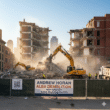Demolition in New York City is an intricate dance of heavy machinery, precise planning, and constant vigilance. Unlike tearing down a barn in a wide-open field, NYC demolition projects are often confined to bustling urban blocks, nestled amidst occupied buildings, active roadways, and a dense population. In such a high-stakes environment, Standard Operating Procedures (SOPs) and stringent safety protocols aren’t just bureaucratic checkboxes; they are the bedrock of successful, incident-free projects and a non-negotiable requirement for any reputable demolition firm.
This is particularly true for companies like Alba Services, which operate in a city with some of the most stringent and frequently updated demolition regulations in the world. Failing to adhere to these standards can have catastrophic consequences, from severe injuries and fatalities to significant financial penalties, legal liabilities, and irreparable damage to a company’s reputation.
The NYC Demolition Landscape: A Unique Challenge
New York City’s unique characteristics elevate the importance of SOPs and safety protocols:
- Density: Buildings are often mere feet apart, sharing party walls or common foundations. This necessitates careful structural analysis and shoring plans to prevent damage to adjacent properties.
- Vibrancy: Active streets, pedestrian traffic, and ongoing business operations around demolition sites mean public safety is paramount. Dust, noise, and falling debris must be meticulously managed.
- Aging Infrastructure: Many NYC buildings are historic, potentially containing hazardous materials like asbestos and lead paint, which require specialized abatement procedures before demolition can safely proceed.
- Rigorous Regulations: The NYC Department of Buildings (DOB), Department of Environmental Protection (DEP), and other agencies enforce a complex web of rules (e.g., Local Law 196 for Site Safety Training) that are constantly being updated based on incident trends and evolving best practices.
The Indispensable Role of SOPs in Demolition
Standard Operating Procedures are detailed, step-by-step instructions that guide workers through specific tasks. In demolition, SOPs are vital for:
- Consistency and Predictability: SOPs ensure that every task, from disconnecting utilities to operating heavy machinery or handling hazardous waste, is performed in the same safe and efficient manner, regardless of the individual worker. This reduces variability and the potential for human error.
- Risk Mitigation: By outlining precise steps and precautions for every conceivable scenario, SOPs proactively identify and address potential hazards. They dictate the use of appropriate Personal Protective Equipment (PPE), safe work zones, and emergency procedures.
- Compliance with Regulations: In NYC, SOPs are often a direct reflection of the city’s complex regulatory framework. They ensure that all work is conducted in accordance with DOB, OSHA, and DEP requirements, minimizing the risk of fines, stop-work orders, and legal issues.
- Worker Training and Onboarding: SOPs serve as invaluable training tools for new employees, rapidly bringing them up to speed on best practices and safety standards. They also provide a clear reference for experienced workers.
- Quality Assurance and Efficiency: When tasks are performed consistently and safely, the overall quality of the demolition work improves. This leads to more efficient project completion, reduced rework, and better resource allocation.
- Accountability: SOPs clearly define roles, responsibilities, and reporting structures, making it easier to assign accountability and investigate incidents if they occur.
- Emergency Preparedness: Detailed SOPs for emergency situations (e.g., unexpected collapse, hazardous material spill, fire) ensure a swift, coordinated, and effective response, potentially saving lives and minimizing damage.
The Imperative of Safety Protocols: A NYC Case Study Perspective
New York City has unfortunately seen its share of construction and demolition accidents, underscoring the critical importance of robust safety protocols. While specific company names are often withheld in public reporting, the types of incidents that occur highlight recurring themes:
- Structural Collapses: A common cause of severe injury or fatality, often due to inadequate structural analysis, improper shoring, or removing load-bearing elements prematurely. Rigorous SOPs for pre-demolition surveys, sequential removal of structural components, and continuous monitoring of adjacent structures are vital to prevent this.
- Falling Debris: Loose materials, tools, or even large structural components can fall from heights, posing a severe risk to workers and the public below. Safety protocols involving debris chutes, catch platforms, robust netting, sidewalk sheds, and clearly marked exclusion zones are crucial.
- Hazardous Material Exposure: Improper handling or unexpected discovery of asbestos, lead, or other toxic substances can lead to severe long-term health issues for workers and environmental contamination. SOPs for comprehensive surveys, proper abatement procedures, specialized PPE, and compliant disposal are non-negotiable.
- Equipment Malfunctions/Operator Error: Heavy machinery requires expert operation and regular maintenance. Accidents can occur due to faulty equipment, improper use, or lack of training. SOPs for equipment inspection, maintenance schedules, operator certification, and safe operating procedures are essential.
- Lack of Communication: Miscommunication between teams, shifts, or with external stakeholders can lead to dangerous oversights. Safety protocols emphasize clear communication channels, pre-shift briefings, and regular coordination meetings.
In 2023, while NYC construction fatalities were down, injuries rose by 25%, with falls and incidents involving mechanical equipment or falling materials being the leading causes. This statistic alone highlights the constant need for vigilance and continuous reinforcement of safety protocols. The DOB continually emphasizes that adherence to city and federal OSHA regulations is paramount, and it’s “incumbent upon contractors, site safety professionals and construction workers to be responsible for adhering to both the city and federal OSHA regulations.”
Alba Services: Where SOPs and Safety Converge
For a company like Alba Services, excelling in the NYC demolition market means placing SOPs and safety protocols at the very core of their operations. Their comprehensive approach includes:
- Detailed Project-Specific Safety Plans: Beyond general SOPs, every project has a tailored safety plan addressing its unique challenges.
- Rigorous Training: Ensuring all personnel, from operators to laborers, are fully trained not only in their tasks but also in all relevant NYC DOB and OSHA safety regulations (e.g., Site Safety Training requirements under Local Law 196).
- State-of-the-Art Equipment: Utilizing modern, well-maintained machinery designed with advanced safety features, backed by SOPs for regular inspections and preventive maintenance.
- Dedicated Safety Personnel: Employing trained safety managers or coordinators who oversee compliance, conduct regular site inspections, and address any potential hazards immediately.
- Environmental Protection: Adhering to strict SOPs for hazardous material abatement, dust suppression (e.g., using water misting systems), and comprehensive recycling to protect both workers and the surrounding environment.
- Proactive Communication: Maintaining open lines of communication with city agencies, clients, and neighboring properties to ensure transparency and address concerns before they escalate.
In a city that never sleeps and is constantly rebuilding itself, the importance of robust SOPs and unwavering safety protocols in demolition cannot be overstated. They are the guardians of lives, reputations, and the integrity of a company’s commitment to responsible urban development. For Alba Services, these are not just good practices; they are the fundamental pillars of their success and their contribution to a safer, more efficient New York City.







